Had the captain not said that we would be the only cruise ship in Aruba? Sure he had, and he had never misspoken yet on these matters. Yet, as we approached the dock, there it was: “The World”, a luxury cruise ship, nicely tied up along the biggest pier. The captain had been right though, things are not always what they look like in this world. “The World” was a cruise ship all right but, for the time being, it was turned into a hotel. Some say a room goes for five million dollars – ownership – and for that kind of money, it moves around the world from time to time too. It made me think of “The World” in Dubai – that wasn’t an island neither, rather a ill-conceived landfill with residential modules on top.
Docking was straightforward, cruise ships are welcome guests: welcome to the Kingdom of the Netherlands, not that Aruba is part of the Netherlands: that would be too easy. Aruba, together with the Netherlands, Saint-Maarten and Curacao belongs to the Dominion of Queen Beatrix. Understanding the world’s complexity, or its frivolity, is not simple, especially if you also consider that Aruba does not have the Euro as its official currency, but the “Florin”, referring to the old Dutch guilder. (Bonaire, formerly the B in the ABC islands chose independence but adopted the Euro).
And if that isn’t enough for fuzziness, here is a twister. Trying to be a nice cosmopolitan, as always, I had got some local money from an ATM in the terminal building. I went to a small shop to buy a cap, and found all articles priced in US Dollars. My cap cost $6 and I gave the attendant 25 Florins (approximately $14). As she started to dole out a few dollars in change, I asked her for some local coins. That she did not have! Two hours later, my taxi driver would react in the same way when I told him that he could keep the change, for a few local notes … no local money!
And all of this trans- and perspired under a heat leaden sky. Aruba is normally a kind of desert but it definitely sports a special climate. The average diurnal temperature is about 80F (27°C) but unlike in real desert conditions, the spread between day and night, irrespective of time of year, is maximally 20F (10°C). They had forecast “partially cloudy” today, but the meaning of that must have gotten lost in tropical calculus. In Belgium they arrive at such an estimate starting at “cloudy” and distracting, (it remains cloudy as a consequence). In Aruba they start from “sunny and clear” and add of few clouds into that. In any event, I was partially cooked!
The island is a paradise. More precisely, it is Eden if you are a beachcomber or a water rat. Barring its beautiful white sandy beaches and an ocean that varies between almost blue, blue, bluer and bluest, with touches of green and purple for good measure, there is next to nothing to see here, nor to do (I did not spend the night, but have not discovered places for night entertainment (Ron and Coca Cola on the Beach perhaps?).
 Our brochure advertized the Natural Bridge, the California Lighthouse and the Casibari Rock formations as must-see. I decide to jump in a taxi and do some quick reconnaissance (because I also had to start planning the last laundry and the early packing). The taxi driver informed me that the 25ft high stone bridge had collapsed in2005. The Lighthouse was closed to the public two years ago, because it had been abused for jumping off. (He added that the suicidal people now just step in the waters off the East coast of the island, and the currents and surf do the rest). That leaves the rocks … they are also 25ft high and cannot collapse because they are lying on the ground! Nobody knows by whom, and why, how or when they were collocated in that little area. I climbed them and discovered their only obvious value: you had a clear 360° view of the grounds, all two hundred square miles of them, almost featureless.
Our brochure advertized the Natural Bridge, the California Lighthouse and the Casibari Rock formations as must-see. I decide to jump in a taxi and do some quick reconnaissance (because I also had to start planning the last laundry and the early packing). The taxi driver informed me that the 25ft high stone bridge had collapsed in2005. The Lighthouse was closed to the public two years ago, because it had been abused for jumping off. (He added that the suicidal people now just step in the waters off the East coast of the island, and the currents and surf do the rest). That leaves the rocks … they are also 25ft high and cannot collapse because they are lying on the ground! Nobody knows by whom, and why, how or when they were collocated in that little area. I climbed them and discovered their only obvious value: you had a clear 360° view of the grounds, all two hundred square miles of them, almost featureless.
Luckily the driver had a few ideas as well, saving my day and, of course, running up his take in the process. The Aruba Tree was the easy part to explore: it is a phenomenon alike to North Sea poplars, they are bent by the wind. In my neck of the woods the trees all, well, bent towards the East but they still standing erect. Not so in Aruba: as soon as they reach 10 feet, they continue to grow horizontally, invariably in a southwesterly direction.
The next stop was a cemetery. I have always found that cemeteries tell a lot about people’s customs and values – toilets, no intended relationship here, although nowadays also called restrooms – serve the same purpose, by the way, albeit in different dimensions. The Arubans rest together, all inthea family, so to speak. And they start under the ground (like most traditional burials) with the oldest “progenitors”. Their kids come on top, usually at ground level, and then they foresee one or two levels for next generations or siblings. In all we are talking about six to eight burial places, all from one family. I have not asked, but I wondered, especially since it was Ash Wednesday, how “returning to ash” works in a dry climate, three feet high?
Finally he suggested that I should shoot a few pictures at Eagle Beach. He must have noticed, if only by my clothes, that I could not have many “aquaphile genes”, but he insisted that it would be worth my while. It was. Although there was not much curvy skin exposed under the unrelenting sun, the pelicans were out in full force – fishing. It was a grand spectacle of which I got a few good shots of happy pelicans!
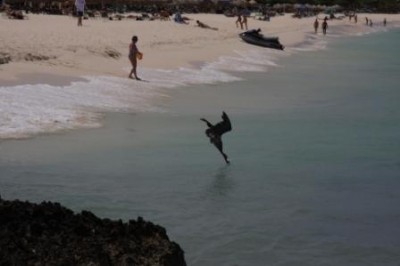 The afternoon was dedicated to training and packing. I say training because folding dress shirts, regular shirts, T-shirts and polo-shirts, in a way deemed acceptable when they arrive home, requires some practice. Meanwhile I noticed a continuous stream of big tankers moving East to West, and others West to East, along the horizon. I guess that it was oil from Chavez for his friends in Cuba. The world is a busy place indeed, also on the infinite oceans.
The afternoon was dedicated to training and packing. I say training because folding dress shirts, regular shirts, T-shirts and polo-shirts, in a way deemed acceptable when they arrive home, requires some practice. Meanwhile I noticed a continuous stream of big tankers moving East to West, and others West to East, along the horizon. I guess that it was oil from Chavez for his friends in Cuba. The world is a busy place indeed, also on the infinite oceans.
The coming days will be busy and radio-silent from my side. I will fly home on Saturday. Stay tune for a few reflections sometime next week! I hope that these stories have been as interesting for ye’all as the voyage has been for me.
Prinsendam, Day 64 – Thursday March 10th, 2011
Getting ready for the last “All Ashore”
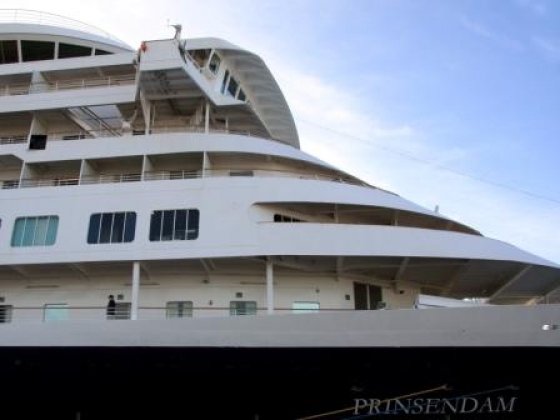
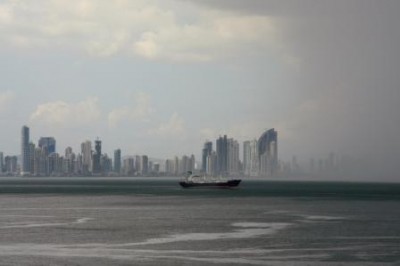 Yet, there are still seven indigenous tribes living in the rain forests of Panama, five in the East and two in the West. The readers, who like me, see Panama as split by the canal in North (Costa Rica) and South (Colombia) parts, better think of North as West and of South as East, as the Panamanians do. The trip started off with a bus ride of one hour, along a highway which was in a better state than the sound system on the bus. To make matters worse it looked as if the hearing impaired were sitting in the back, such that the front sitters started complaining when the guide turned up the decibels. Switching places would obviously have been an effective solution, were it not for the fact that the less mobile were also in the back of the bus …
Yet, there are still seven indigenous tribes living in the rain forests of Panama, five in the East and two in the West. The readers, who like me, see Panama as split by the canal in North (Costa Rica) and South (Colombia) parts, better think of North as West and of South as East, as the Panamanians do. The trip started off with a bus ride of one hour, along a highway which was in a better state than the sound system on the bus. To make matters worse it looked as if the hearing impaired were sitting in the back, such that the front sitters started complaining when the guide turned up the decibels. Switching places would obviously have been an effective solution, were it not for the fact that the less mobile were also in the back of the bus … 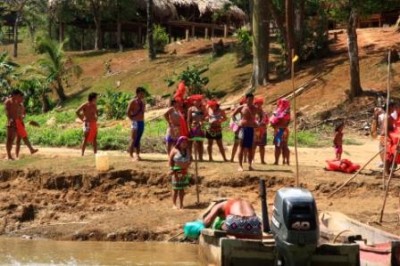 Nowhere was there any hint that they had (to) put up a show. We could see where they live, we could take pictures (not in the private dwellings), they explained (in Spanish) what they do and how they do it (a standard 20ft canoe is two months of hard work for seven able bodies), we could buy their artifacts of course, and nobody was begging. Although the villages of the Embera are isolated, allowing them to continue to adhere to culture and language, they are certainly not living in the wild. It was all relaxed, pleasant and instructive. I was lucky to bump into a resident (Greek) anthropologist as well; he explained how democratic and socially caring they all are where it comes to tribal affairs.
Nowhere was there any hint that they had (to) put up a show. We could see where they live, we could take pictures (not in the private dwellings), they explained (in Spanish) what they do and how they do it (a standard 20ft canoe is two months of hard work for seven able bodies), we could buy their artifacts of course, and nobody was begging. Although the villages of the Embera are isolated, allowing them to continue to adhere to culture and language, they are certainly not living in the wild. It was all relaxed, pleasant and instructive. I was lucky to bump into a resident (Greek) anthropologist as well; he explained how democratic and socially caring they all are where it comes to tribal affairs.  I mention the latter only because I had firsthand experience with it. Indeed, we flew from Manta, where we were docked, to Quito in the early morning; clockwork orange, in a brand new A319, with free snacks and coffee. The return flight was a different story though. Our flight was “in suspense” because the Control Tower in Manta had experienced catastrophic failure, whatever that may mean. Eventually, we were rerouted to the “old, small airport”. A 30-seat Dornier 328 propjet – my maiden flight – brought us back to the old and small airport just before scheduled sailing time.
I mention the latter only because I had firsthand experience with it. Indeed, we flew from Manta, where we were docked, to Quito in the early morning; clockwork orange, in a brand new A319, with free snacks and coffee. The return flight was a different story though. Our flight was “in suspense” because the Control Tower in Manta had experienced catastrophic failure, whatever that may mean. Eventually, we were rerouted to the “old, small airport”. A 30-seat Dornier 328 propjet – my maiden flight – brought us back to the old and small airport just before scheduled sailing time.
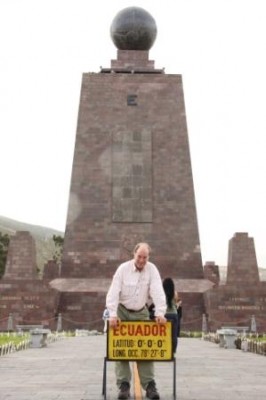 Of course, I also went to “La Mitad del Mundo”, the place at opposite ends of the continent from Macapà, in Brazil. Actually, it is here that (primarily) French scientist made the first exact scientific measurements about the earth’s equator. And, of course, I had my picture taken with one leg in the Northern and one in the Southern Hemisphere, simultaneously! The journey (journée) in Ecuador was a welcome reprieve from the choc of Peru: diversity and energy, both figuratively and literally. And there was lots of joy on the streets – Carnival is around the corner, as well!
Of course, I also went to “La Mitad del Mundo”, the place at opposite ends of the continent from Macapà, in Brazil. Actually, it is here that (primarily) French scientist made the first exact scientific measurements about the earth’s equator. And, of course, I had my picture taken with one leg in the Northern and one in the Southern Hemisphere, simultaneously! The journey (journée) in Ecuador was a welcome reprieve from the choc of Peru: diversity and energy, both figuratively and literally. And there was lots of joy on the streets – Carnival is around the corner, as well! The neo-classical part of Lima is, in a less cozy but more monumental way, just as impressive. And it is well kept. That has everything to do with the simple fact that it is the place where the current powers hold office: the presidential palace, the mayoral palace, the “social club of Lima”, the cathedral and Episcopal Palace, the Franciscan Monastery, the headquarters of the banks, as well as related institutes and institutions. The parks, filled with perennial rainbows of blossoming flowers, give it all a relaxed and pleasant atmosphere.
The neo-classical part of Lima is, in a less cozy but more monumental way, just as impressive. And it is well kept. That has everything to do with the simple fact that it is the place where the current powers hold office: the presidential palace, the mayoral palace, the “social club of Lima”, the cathedral and Episcopal Palace, the Franciscan Monastery, the headquarters of the banks, as well as related institutes and institutions. The parks, filled with perennial rainbows of blossoming flowers, give it all a relaxed and pleasant atmosphere.  The average annual GDP per head is five thousand dollars. (By the way, this compares with a salary of eight thousand dollars per month for one of Lima’s district mayors or any member of parliament). Thirty-six percent of Peruvians live below the (Peruvian) poverty line; twelve percent are labeled “extremely poor”. Estimates put the number of poor people in Lima province at 75%, unfortunately.
The average annual GDP per head is five thousand dollars. (By the way, this compares with a salary of eight thousand dollars per month for one of Lima’s district mayors or any member of parliament). Thirty-six percent of Peruvians live below the (Peruvian) poverty line; twelve percent are labeled “extremely poor”. Estimates put the number of poor people in Lima province at 75%, unfortunately.  Meandering though the last patches of road, still strewn with an unimaginable variety of garbage, we arrived at Tambo Colorado. With the desert to the West and South, and the Andes to the East, it benefits from the grandiose setting. It was touted, in the tour guides, as resembling Pompeii. Even injecting a lot of imagination, it is not: especially under the white light of the midday sun, you have to have good eyesight and be wide awake to discern the red, and especially the yellow wall paint (let alone paintings, or frescos!).
Meandering though the last patches of road, still strewn with an unimaginable variety of garbage, we arrived at Tambo Colorado. With the desert to the West and South, and the Andes to the East, it benefits from the grandiose setting. It was touted, in the tour guides, as resembling Pompeii. Even injecting a lot of imagination, it is not: especially under the white light of the midday sun, you have to have good eyesight and be wide awake to discern the red, and especially the yellow wall paint (let alone paintings, or frescos!).  Meanwhile I had been told that the host and owner was actually the Minister of Finance of Peru. He and his wife had started this hacienda twenty years ago and made it a green pearl in the surrounding desert (using water from the more or less seasonal Pisco River nearby). After next month’s elections he will be able to spend more time here again, I heard. The textile shop was actually an initiative of his wife. She had started a campaign, a long time ago, against domestic violence that culminated in gathering a number of women to make handicrafts, using traditional techniques. Today they number thirty-five, and produce beautiful artifacts (tapestry, handbags) in this otherwise desolate region.
Meanwhile I had been told that the host and owner was actually the Minister of Finance of Peru. He and his wife had started this hacienda twenty years ago and made it a green pearl in the surrounding desert (using water from the more or less seasonal Pisco River nearby). After next month’s elections he will be able to spend more time here again, I heard. The textile shop was actually an initiative of his wife. She had started a campaign, a long time ago, against domestic violence that culminated in gathering a number of women to make handicrafts, using traditional techniques. Today they number thirty-five, and produce beautiful artifacts (tapestry, handbags) in this otherwise desolate region.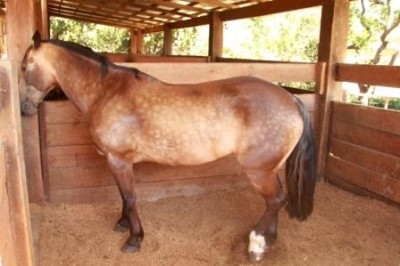 A girl of thirteen then, emphasizing how many lives revolve around horses, crawled between her horse’s front legs and hind legs, closing out her demonstration of trust between human and animal by inducting the horse to lay down, while she was sitting in the saddle. Quite a feat, I am told by people that know more about horses than I do. Rodeo is not only horses; it is also women, sorry – dancing. The Chilean “cueca” (national dance) is based on the rooster seducing the chicken. The only comment that I can make about it is that Belgian roosters do not waste all the time that Chilean roosters do, at least of the dance is a reliable rendition of the rooster’s behavior.
A girl of thirteen then, emphasizing how many lives revolve around horses, crawled between her horse’s front legs and hind legs, closing out her demonstration of trust between human and animal by inducting the horse to lay down, while she was sitting in the saddle. Quite a feat, I am told by people that know more about horses than I do. Rodeo is not only horses; it is also women, sorry – dancing. The Chilean “cueca” (national dance) is based on the rooster seducing the chicken. The only comment that I can make about it is that Belgian roosters do not waste all the time that Chilean roosters do, at least of the dance is a reliable rendition of the rooster’s behavior. Prinsendam, Day 53 – Saturday Feb 26th, 2011
Prinsendam, Day 53 – Saturday Feb 26th, 2011 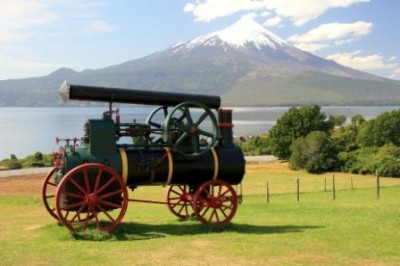 Driving past the various lake beaches on a summer Sunday afternoon, I was struck by the skin color of the locals: contrary to other parts of South America that I have visited so far, the general tendency was for pale skins. Indeed, I have seen a few real redheads, as they also sported authentic freckles! I have been told that very few Indians (Mapiche) survived the early colonization and that the area, from the coast all the way to the Lake Llanquihue, has been settled by Germans primarily. Traces of that influence could be seen in building styles and store names. I also detected a fire brigade truck that had “Feuerwehr” written across it!
Driving past the various lake beaches on a summer Sunday afternoon, I was struck by the skin color of the locals: contrary to other parts of South America that I have visited so far, the general tendency was for pale skins. Indeed, I have seen a few real redheads, as they also sported authentic freckles! I have been told that very few Indians (Mapiche) survived the early colonization and that the area, from the coast all the way to the Lake Llanquihue, has been settled by Germans primarily. Traces of that influence could be seen in building styles and store names. I also detected a fire brigade truck that had “Feuerwehr” written across it!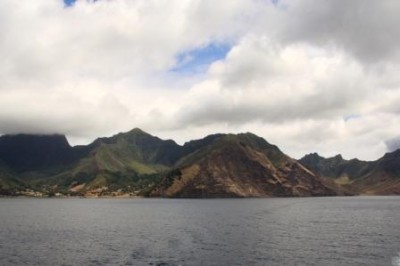 Rather than spending time in the tourist area with all the gift shops (imported from the mainland), I decided to go for gold: Alexander’s Lookout or “Mirador Selkirk”. The info board stated 2700m. Since that could not be the height, it had to be the length. After fifteen minutes uphill I had left the houses behind me, as well as all (imagined) competitors. Another fifteen minutes and my heartbeat was way up and my shirt started to change color. The first patch of rain forest had been traversed and, the path turned less steep. Another half a mile I detected a lookout point, a couple of hundred meters below the saddle.
Rather than spending time in the tourist area with all the gift shops (imported from the mainland), I decided to go for gold: Alexander’s Lookout or “Mirador Selkirk”. The info board stated 2700m. Since that could not be the height, it had to be the length. After fifteen minutes uphill I had left the houses behind me, as well as all (imagined) competitors. Another fifteen minutes and my heartbeat was way up and my shirt started to change color. The first patch of rain forest had been traversed and, the path turned less steep. Another half a mile I detected a lookout point, a couple of hundred meters below the saddle. 
 By seven, all that needed to be checked and repaired was checked and repaired, and the skipper announced our imminent re-departure. Instead of the planned “easy going, meandering route” (through the Darwin Canal) we needed to make up time and we would venture into the fjords a little bit more to the North. I cannot compare the route with the other alternatives, but sailing this last segment of the day, through the (wider) fjords, proved to be a gentle reminder of what we probably had missed. With the sun slow-diving into the open ocean behind us, we were witnesses to a water-and-light show, with the odd snow-covered mountain or volcano in the background. It was a pleasure for the senses.
By seven, all that needed to be checked and repaired was checked and repaired, and the skipper announced our imminent re-departure. Instead of the planned “easy going, meandering route” (through the Darwin Canal) we needed to make up time and we would venture into the fjords a little bit more to the North. I cannot compare the route with the other alternatives, but sailing this last segment of the day, through the (wider) fjords, proved to be a gentle reminder of what we probably had missed. With the sun slow-diving into the open ocean behind us, we were witnesses to a water-and-light show, with the odd snow-covered mountain or volcano in the background. It was a pleasure for the senses.  Even though there was some compensation sailing through the last fjords in the dying light, I would have preferred the normal route (the so-called Magellan) through the fjords, past the ice fields and the glaciers of the famed “Campo de Hielo Sur” but we cannot instruct Nature to please us as we wish, luckily, for otherwise the ostentatious arrogance of 21st century (western) man (and woman – no discrimination here!) would culminate in speedy self destruction.
Even though there was some compensation sailing through the last fjords in the dying light, I would have preferred the normal route (the so-called Magellan) through the fjords, past the ice fields and the glaciers of the famed “Campo de Hielo Sur” but we cannot instruct Nature to please us as we wish, luckily, for otherwise the ostentatious arrogance of 21st century (western) man (and woman – no discrimination here!) would culminate in speedy self destruction.  After all the rough seas in Antarctica, the Drake Passage was, if not a pleasant reprieve, a bit less punishing; but just a bit. The captain suggested that we were lucky: in his experience the conditions were “pretty good”. The sun was definitely shining and the horizon existed, visibly so. The clemency of the ocean was relative though, for the waves were about seven feet but the swell from the Pacific – the furious fifties – was estimated to be upwards of sixteen feet. Arithmetic – here I go again! – teaches us that the maximum waves will be twenty four feet, or more. And they were! Actually, every so often, spread anywhere between thirty and ninety seconds apart, we were hit by a “big long wave”: it pummels and lifts the ship from portside bow such that it shudders across its full length. Seaman’s legs were called for if you wanted to move about. We made it to Cape Horn by 1900hrs and, contrary to its usual garments – fog and rain – it was basking in the fading sunshine! Just splendid.
After all the rough seas in Antarctica, the Drake Passage was, if not a pleasant reprieve, a bit less punishing; but just a bit. The captain suggested that we were lucky: in his experience the conditions were “pretty good”. The sun was definitely shining and the horizon existed, visibly so. The clemency of the ocean was relative though, for the waves were about seven feet but the swell from the Pacific – the furious fifties – was estimated to be upwards of sixteen feet. Arithmetic – here I go again! – teaches us that the maximum waves will be twenty four feet, or more. And they were! Actually, every so often, spread anywhere between thirty and ninety seconds apart, we were hit by a “big long wave”: it pummels and lifts the ship from portside bow such that it shudders across its full length. Seaman’s legs were called for if you wanted to move about. We made it to Cape Horn by 1900hrs and, contrary to its usual garments – fog and rain – it was basking in the fading sunshine! Just splendid. Our guide made this tour an indelible success, thanks to his in-depth knowledge of nature, his passionate talking, his excellent English and his remarkable driving skills. One of the interesting stories that he told us, concerns the beavers, which are not indigenous to the island. About fifty years ago, English fur dealers started breading Canadian beavers in captivity. However, because of the climate, these animals “adapted”, and the thickness of their hives decreased by more than half. Uneconomical, the business was abandoned and the beavers … set free. Initially they were kept in check by the red foxes, but these got almost hunted to extinction (also for hives). The beaver community flourished!
Our guide made this tour an indelible success, thanks to his in-depth knowledge of nature, his passionate talking, his excellent English and his remarkable driving skills. One of the interesting stories that he told us, concerns the beavers, which are not indigenous to the island. About fifty years ago, English fur dealers started breading Canadian beavers in captivity. However, because of the climate, these animals “adapted”, and the thickness of their hives decreased by more than half. Uneconomical, the business was abandoned and the beavers … set free. Initially they were kept in check by the red foxes, but these got almost hunted to extinction (also for hives). The beaver community flourished! With that unexpected touristic “encore” – Octopus is a pearl; it permanently sports also a helicopter and a mini submarine (visible in the back of the helipad) – we set sail for the continent, through the Beagle Channel, and past the Cordillera Darwin. The weather gods were protecting us, and Mother Nature complied by dishing up exquisite panoramas, filled with granite peaks, steely glaciers, waterfalls, forest, peat moss, little inlets and fjords … Darwin and Fitz Roy must have marveled, for hundred and sixty years ago, it undoubtedly must have more brilliant still. Our cruise-by was commented by an expert, so that I was busy for four hours, running in and out of my cabin, taking many pictures, all part of the “Oooh” and ”Woow” and “Geee” species, or genus, as the case may be. I need not explain that it was breath taking, both literally and figuratively.
With that unexpected touristic “encore” – Octopus is a pearl; it permanently sports also a helicopter and a mini submarine (visible in the back of the helipad) – we set sail for the continent, through the Beagle Channel, and past the Cordillera Darwin. The weather gods were protecting us, and Mother Nature complied by dishing up exquisite panoramas, filled with granite peaks, steely glaciers, waterfalls, forest, peat moss, little inlets and fjords … Darwin and Fitz Roy must have marveled, for hundred and sixty years ago, it undoubtedly must have more brilliant still. Our cruise-by was commented by an expert, so that I was busy for four hours, running in and out of my cabin, taking many pictures, all part of the “Oooh” and ”Woow” and “Geee” species, or genus, as the case may be. I need not explain that it was breath taking, both literally and figuratively. To conclude, and since Punta Arenas itself has little else that is worthwhile to mention, I ought to report our encounter with an old, and abandoned coal mine. Indeed, as we were descending a slippery, somewhat steep and circuitous path in the forest, we ended up at a hole, filled to the brim with black water. The ventilation duct – for that is what we had stumbled onto – was squared off: four sturdy round poles at the corners, and twee lateral planks, about 4 inches wide, one at chest height, and the other a couple of feet above the ground.
To conclude, and since Punta Arenas itself has little else that is worthwhile to mention, I ought to report our encounter with an old, and abandoned coal mine. Indeed, as we were descending a slippery, somewhat steep and circuitous path in the forest, we ended up at a hole, filled to the brim with black water. The ventilation duct – for that is what we had stumbled onto – was squared off: four sturdy round poles at the corners, and twee lateral planks, about 4 inches wide, one at chest height, and the other a couple of feet above the ground.  Describing the visual and auditory experience that Antarctica offers, is a challenge that I have no intention of taking on. Even though they say that one picture is worth a thousand words, a thousand pictures cannot commence to convey Antarctica, not even the little patch that I would be visiting. In the end it is this enormous variety of physical and biological creation, which hits you continuously right up in your face, that makes the Antarctic wilderness into the grandiose attraction that it really is.
Describing the visual and auditory experience that Antarctica offers, is a challenge that I have no intention of taking on. Even though they say that one picture is worth a thousand words, a thousand pictures cannot commence to convey Antarctica, not even the little patch that I would be visiting. In the end it is this enormous variety of physical and biological creation, which hits you continuously right up in your face, that makes the Antarctic wilderness into the grandiose attraction that it really is.  By early afternoon the wind suddenly picked up and we made out to the Bismarck Strait. That is a relatively wide thoroughfare along the southern shores of Anvers Island, albeit not free of drifting ice, in all shapes and sizes. After gusting up to 60kts, mixing in some snow for good measure, the icy, bone-chilling wind died down. But by then the bridge had decided to call it a day, as far as sightseeing was concerned. That would prove to have been a wise decision.
By early afternoon the wind suddenly picked up and we made out to the Bismarck Strait. That is a relatively wide thoroughfare along the southern shores of Anvers Island, albeit not free of drifting ice, in all shapes and sizes. After gusting up to 60kts, mixing in some snow for good measure, the icy, bone-chilling wind died down. But by then the bridge had decided to call it a day, as far as sightseeing was concerned. That would prove to have been a wise decision.  had encountered all over the place, visibility allowing.
had encountered all over the place, visibility allowing.  They had starting mating and hatching by the end of September. Most of the newborn were already trotting around; some were ready for their maiden dive, others had to lose a little bit more chick-y down. Ostensibly that was a task for the ubiquitous wind. Countless carcasses were littering the grounds too, varying between just deceased to bone-picked. Apparently penguins are conversant with Darwin: parents decide amongst themselves which from their two chicks will be most likely to survive, and they just let the weakest wither in the wind, literally and figuratively.
They had starting mating and hatching by the end of September. Most of the newborn were already trotting around; some were ready for their maiden dive, others had to lose a little bit more chick-y down. Ostensibly that was a task for the ubiquitous wind. Countless carcasses were littering the grounds too, varying between just deceased to bone-picked. Apparently penguins are conversant with Darwin: parents decide amongst themselves which from their two chicks will be most likely to survive, and they just let the weakest wither in the wind, literally and figuratively. The countryside is equally unimpressive, not to say outright boring: shallowly rolling hills, relatively green pasture and bush, with little or no movement. I was told that it hides 6 million heads of cattle and double that amount of sheep. More towards the North the land gets hillier and shadier, and at its extreme Western side it offers great Atlantic sandy beaches, culminating in rich and prosperous Punta del Este. That resort is also a magnet for rich Porteños (=inhabitants of Buenos Aires), who bought second or third residences on that side of the river.
The countryside is equally unimpressive, not to say outright boring: shallowly rolling hills, relatively green pasture and bush, with little or no movement. I was told that it hides 6 million heads of cattle and double that amount of sheep. More towards the North the land gets hillier and shadier, and at its extreme Western side it offers great Atlantic sandy beaches, culminating in rich and prosperous Punta del Este. That resort is also a magnet for rich Porteños (=inhabitants of Buenos Aires), who bought second or third residences on that side of the river. 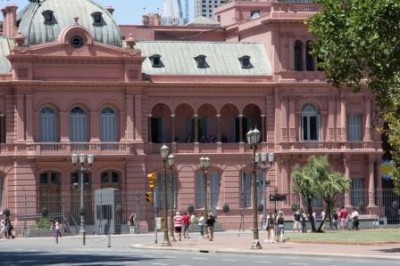 I visited the city by bike, too. It was my first ride since my shoulder operation. The bike did not resemble the vehicle that I am used to, but two working brakes gave me enough confidence to dive into the Monday morning traffic. The idea was to drive more or less along the Plata River, towards the southern origins of the city. The end objective was “La Boca”, home of the world famous Boca Juniors soccer team. That is also the neighborhood, and the team, where world famous Diego Maradonna spent his youth. La Boca has nothing in common with downtown, even the language, already a stretch to understand in the center of the city, becomes a garbling of zjjjjjs and strange nasals.
I visited the city by bike, too. It was my first ride since my shoulder operation. The bike did not resemble the vehicle that I am used to, but two working brakes gave me enough confidence to dive into the Monday morning traffic. The idea was to drive more or less along the Plata River, towards the southern origins of the city. The end objective was “La Boca”, home of the world famous Boca Juniors soccer team. That is also the neighborhood, and the team, where world famous Diego Maradonna spent his youth. La Boca has nothing in common with downtown, even the language, already a stretch to understand in the center of the city, becomes a garbling of zjjjjjs and strange nasals.  After three and a half hours of meandering, mixed with some deft moves, the “Tour” was came full circle, and we were all safely back in the port, although many butts did visibly hurt. To restore the burnt calories, I ate a spaghetti-pomodori, plus a vanilla-chocolate ice cream, before a well-earned siesta. At 4pm the captain called us all onto the deck for the monthly “Abandon Ship” drill. There were about one hundred passengers at Lifeboat #3. As part of the procedure the skipper did his best to explain that we would all fit in our boat, if we followed the directions of the crew. He added that he did not expect such a situation to actually happen! I, for one, do not believe, after two of these sessions and judging by the experience with tender operations to shore, using those same sloops, that we all fit in the Lifeboat #3. Therefore, I wholeheartedly share his hope and expectations.
After three and a half hours of meandering, mixed with some deft moves, the “Tour” was came full circle, and we were all safely back in the port, although many butts did visibly hurt. To restore the burnt calories, I ate a spaghetti-pomodori, plus a vanilla-chocolate ice cream, before a well-earned siesta. At 4pm the captain called us all onto the deck for the monthly “Abandon Ship” drill. There were about one hundred passengers at Lifeboat #3. As part of the procedure the skipper did his best to explain that we would all fit in our boat, if we followed the directions of the crew. He added that he did not expect such a situation to actually happen! I, for one, do not believe, after two of these sessions and judging by the experience with tender operations to shore, using those same sloops, that we all fit in the Lifeboat #3. Therefore, I wholeheartedly share his hope and expectations.